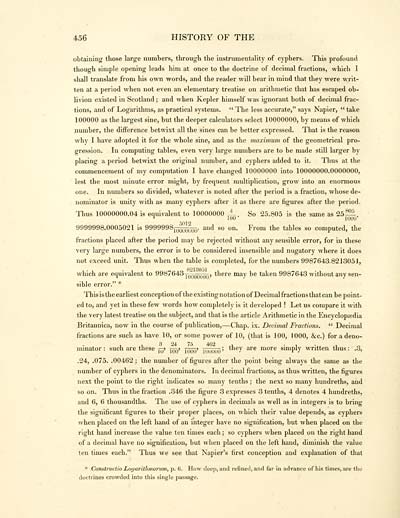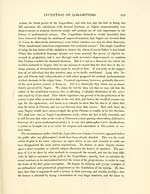Memoirs of John Napier of Merchiston
(498) Page 456
Download files
Complete book:
Individual page:
Thumbnail gallery: Grid view | List view

456 HISTORY OF THE
obtaining those large numbers, through the instrumentality of cyphers. This profound
though simple opening leads him at once to the doctrine of decimal fractions, which I
shall translate from his own words, and the reader will bear in mind that they were writ-
ten at a period when not even an elementary treatise on arithmetic that has escaped ob-
livion existed in Scotland ; and when Kepler himself was ignorant both of decimal frac-
tions, and of Logarithms, as practical systems. " The less accurate," says Napier, " take
100000 as the largest sine, but the deeper calculators select 10000000, by means of which
number, the difference betwixt all the sines can be better expressed. That is the reason
why I have adopted it for the whole sine, and as the maximum of the geometrical pro-
gression. In computing tables, even very large numbers are to be made still larger by
placing a period betwixt the original number, and cyphers added to it. Thus at the
commencement of my computation I have changed 10000000 into 10000000.0000000,
lest the most minute error might, by frequent multiplication, grow into an enormous
one. In numbers so divided, whatever is noted after the period is a fraction, whose de-
nominator is unity with as many cyphers after it as there are figures after the period.
Thus 10000000.04 is equivalent to 10000000 * So 25.805 is the same as 25—.
1 100 1UU0
501°
9999998.0005021 is 9999998^^^. and so on. From the tables so computed, the
fractions placed after the period may be rejected without any sensible error, for in these
very large numbers, the error is to be considered insensible and nugatory where it does
not exceed unit. Thus when the table is completed, for the numbers 9987643.8213051,
which are equivalent to 9987 643-^^^, there may be taken 9987643 without any sen-
sible error." *
This is the earliest conception of the existing notation of Decimal fractions that can be point-
ed to, and yet in these few words how completely is it developed ! Let us compare it with
the very latest treatise on the subject, and that is the article Arithmetic in the Encyclopaedia
Britannica, now in the course of publication, — Chap. ix. Decimal Fractions. " Decimal
fractions are such as have 10, or some power of 10, (that is 100, 1000, &c.) for a deno-
minator : such are these jy j^> j^g> Iuuuu0 ; they are more simply written thus : .3,
.24, .075. .00462 ; the number of figures after the point being always the same as the
number of cyphers in the denominators. In decimal fractions, as thus written, the figures
next the point to the right indicates so many tenths ; the next so many hundreths, and
so on. Thus in the fraction .346 the figure 3 expresses 3 tenths, 4 denotes 4 hundreths,
and 6, 6 thousandths. The use of cyphers in decimals as well as in integers is to bring
the significant figures to their proper places, on which their value depends, as cyphers
when placed on the left hand of an integer have no signification, but when placed on the
right hand increase the value ten times each ; so cyphers when placed on the right hand
of a decimal have no signification, but when placed on the left hand, diminish the value
ten times each." Thus we see that Napier's first conception and explanation of that
* Constructio Logarithmorum, p. 6. How deep, and refined, and far in advance of his times, are the
doctrines crowded into this single passage.
obtaining those large numbers, through the instrumentality of cyphers. This profound
though simple opening leads him at once to the doctrine of decimal fractions, which I
shall translate from his own words, and the reader will bear in mind that they were writ-
ten at a period when not even an elementary treatise on arithmetic that has escaped ob-
livion existed in Scotland ; and when Kepler himself was ignorant both of decimal frac-
tions, and of Logarithms, as practical systems. " The less accurate," says Napier, " take
100000 as the largest sine, but the deeper calculators select 10000000, by means of which
number, the difference betwixt all the sines can be better expressed. That is the reason
why I have adopted it for the whole sine, and as the maximum of the geometrical pro-
gression. In computing tables, even very large numbers are to be made still larger by
placing a period betwixt the original number, and cyphers added to it. Thus at the
commencement of my computation I have changed 10000000 into 10000000.0000000,
lest the most minute error might, by frequent multiplication, grow into an enormous
one. In numbers so divided, whatever is noted after the period is a fraction, whose de-
nominator is unity with as many cyphers after it as there are figures after the period.
Thus 10000000.04 is equivalent to 10000000 * So 25.805 is the same as 25—.
1 100 1UU0
501°
9999998.0005021 is 9999998^^^. and so on. From the tables so computed, the
fractions placed after the period may be rejected without any sensible error, for in these
very large numbers, the error is to be considered insensible and nugatory where it does
not exceed unit. Thus when the table is completed, for the numbers 9987643.8213051,
which are equivalent to 9987 643-^^^, there may be taken 9987643 without any sen-
sible error." *
This is the earliest conception of the existing notation of Decimal fractions that can be point-
ed to, and yet in these few words how completely is it developed ! Let us compare it with
the very latest treatise on the subject, and that is the article Arithmetic in the Encyclopaedia
Britannica, now in the course of publication, — Chap. ix. Decimal Fractions. " Decimal
fractions are such as have 10, or some power of 10, (that is 100, 1000, &c.) for a deno-
minator : such are these jy j^> j^g> Iuuuu0 ; they are more simply written thus : .3,
.24, .075. .00462 ; the number of figures after the point being always the same as the
number of cyphers in the denominators. In decimal fractions, as thus written, the figures
next the point to the right indicates so many tenths ; the next so many hundreths, and
so on. Thus in the fraction .346 the figure 3 expresses 3 tenths, 4 denotes 4 hundreths,
and 6, 6 thousandths. The use of cyphers in decimals as well as in integers is to bring
the significant figures to their proper places, on which their value depends, as cyphers
when placed on the left hand of an integer have no signification, but when placed on the
right hand increase the value ten times each ; so cyphers when placed on the right hand
of a decimal have no signification, but when placed on the left hand, diminish the value
ten times each." Thus we see that Napier's first conception and explanation of that
* Constructio Logarithmorum, p. 6. How deep, and refined, and far in advance of his times, are the
doctrines crowded into this single passage.
Set display mode to:
![]() Universal Viewer |
Universal Viewer | ![]() Mirador |
Large image | Transcription
Mirador |
Large image | Transcription
Images and transcriptions on this page, including medium image downloads, may be used under the Creative Commons Attribution 4.0 International Licence unless otherwise stated. ![]()
| Histories of Scottish families > Memoirs of John Napier of Merchiston > (498) Page 456 |
|---|
| Permanent URL | https://digital.nls.uk/95434207 |
|---|
| Description | A selection of almost 400 printed items relating to the history of Scottish families, mostly dating from the 19th and early 20th centuries. Includes memoirs, genealogies and clan histories, with a few produced by emigrant families. The earliest family history goes back to AD 916. |
|---|

